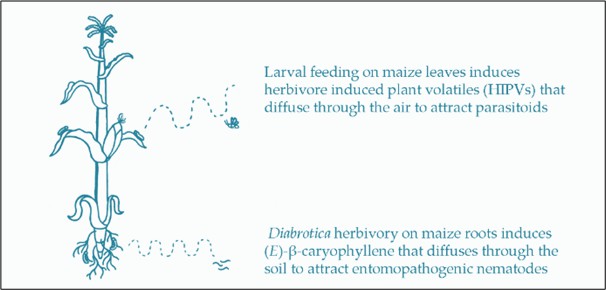Lifeasible is dedicated to environmentally friendly plant protection research and provides services to help investigate the anti-insect mechanisms of plant primary metabolites, plant secondary metabolites, and microbial metabolites to promote the application of natural metabolites in plant protection.
Pests are a major factor in agricultural losses, and the development of environmentally friendly pest control solutions is of great value for the sustainability of agriculture. It is essential to discover anti-insect substances from plant and microbial metabolites (especially metabolites of pest pathogens) and to study their anti-insect mechanisms. The direct anti-insect mechanisms of the currently discovered anti-insect metabolites are diverse. They include blocking and interfering with the insect nervous system, inhibiting cellular respiration, disturbing insect hormone homeostasis, and disrupting chitin synthesis in the insect exoskeleton. And some plant metabolites attract natural enemies of pests or have poor taste and odor, thus indirectly resisting insects.
 Fig. 1 Volatile compounds in maize as an indirect defense to control the attacking pest (Yactayo-Chang et al., 2020).
Fig. 1 Volatile compounds in maize as an indirect defense to control the attacking pest (Yactayo-Chang et al., 2020).
Lifeasible provides services to assist in studying metabolite anti-insect mechanisms, and we focus on the direct anti-insect mechanisms of metabolites.
Study on the direct anti-insect mechanism of metabolites
We provide services to explore anti-insect mechanisms of the metabolite from multiple levels of insects, including cellular, tissue, organ, and organ system levels. We also offer services to explore metabolite anti-insect mechanisms in a targeted manner with reference to the discovered anti-insect mechanisms. We fully understand the anti-insect mechanism of various metabolites and have accumulated rich experience in studying the anti-insect mechanism of metabolites. We can help our customers to achieve efficient anti-insect mechanism exploration.
Study on the indirect anti-insect mechanism of metabolites
We provide services to assist in studying indirect anti-insect mechanisms of metabolites. Our in-depth knowledge of plant metabolism and plant protection mechanisms enhances our ability to explore indirect anti-insect mechanisms of metabolites.
Exploration of anti-insect mechanisms aided by structural analysis of metabolites
We will first analyze the metabolites' structures to speculate on their possible anti-insect mechanisms. Based on the metabolite database we have established to record the metabolite structure and plant protection functions. We can obtain a general direction of their anti-insect mechanisms based on their structures.
Preliminary exploration of the anti-insect mechanism
Pests behave differently with different anti-insect mechanisms of metabolites. For example, neurotoxic metabolites acting on pests can cause them to convulse. Based on the behavior of pests, we can infer the anti-insect mechanism at the organ system -level. In addition, toxic activity experiments using insect cell lines can quickly discover cell-level anti-insect mechanisms. We combine insect performance in anti-insect experiments with cytotoxic activity experiments to help preliminarily discover the anti-insect mechanisms of metabolites.
In-depth exploration of the anti-insect mechanism
After the preliminary exploration of the anti-insect mechanism of metabolites, we will conduct an in-depth exploration using multiple approaches. After knowing the organ system-level anti-insect mechanisms of metabolites, we will perform tissue-level exploration of the anti-insect mechanism by insect dissection and tissue detection. After knowing the cell-level anti-insect mechanisms of metabolites, we will conduct experiments such as enzyme activity assay, transcriptome assay, signaling pathway assay, and metabolome assay to help explore the more detailed anti-insect mechanism.
Some substances in the metabolites of insect pathogenic microorganisms, plant metabolites, and plant endophyte metabolites have anti-insect activity. We help to explore their anti-insect mechanisms. Lifeasible masters professional research methods that can help efficiently study anti-insect mechanisms. If you need any further assistance, please contact us.
References